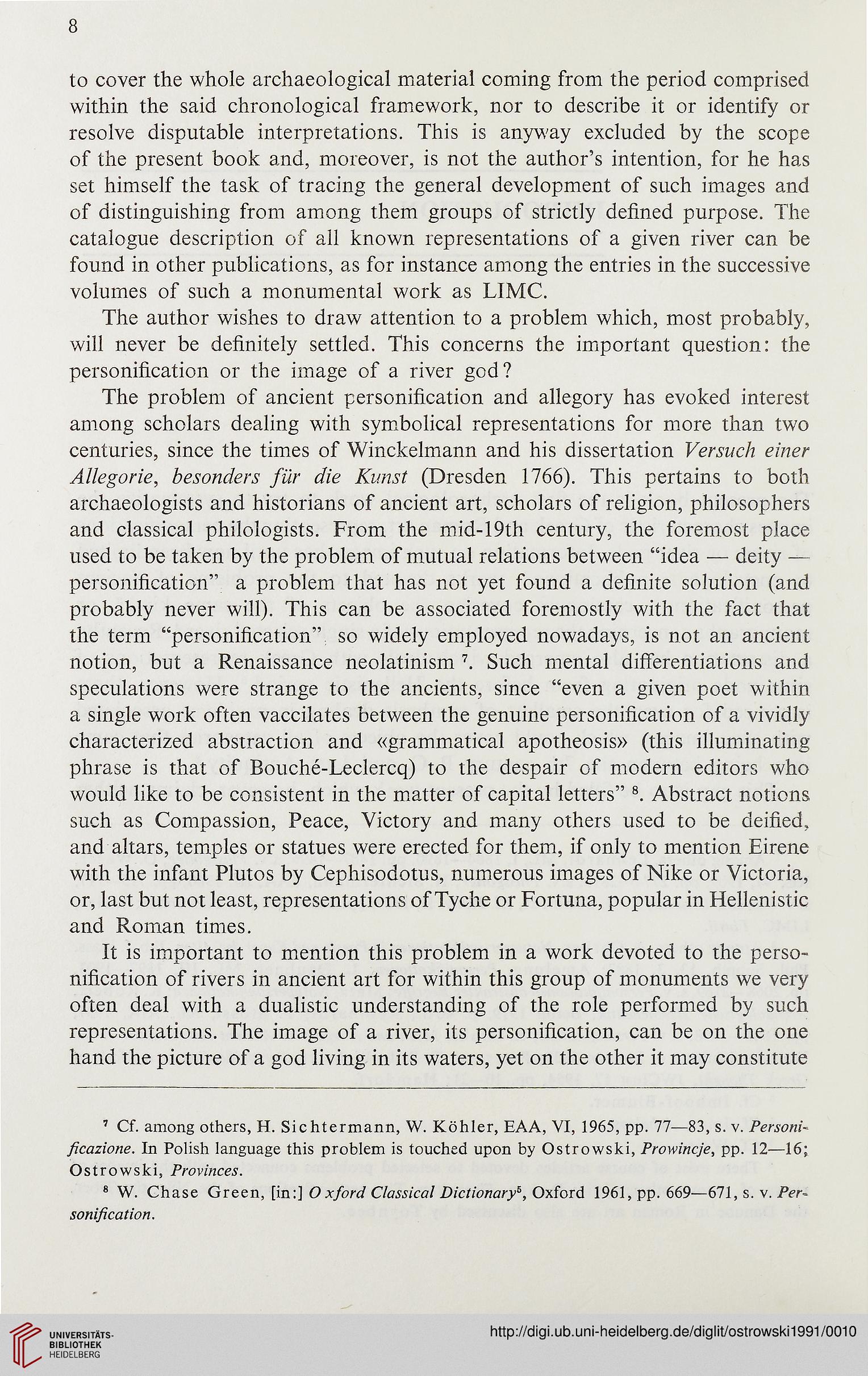to cover the whole archaeological material coming from the period comprised
within the said chronological framework, nor to describe it or identify or
resolve disputable interpretations. This is anyway excluded by the scope
of the present book and, moreover, is not the author’s intention, for he has
set himself the task of tracing the general development of such images and
of distinguishing from among them groups of strictly defined purpose. The
catalogue description of all known representations of a given river can be
found in other publications, as for instance among the entries in the successive
volumes of such a monumental work as LIMC.
The author wishes to draw attention to a problem which, most probably,
will never be definitely settled. This concerns the important question: the
personification or the image of a river god?
The problem of ancient personification and allegory has evoked interest
among scholars dealing with symbolical representations for more than two
centuries, since the times of Winckelmann and his dissertation Versuch einer
Allegorie, besonders fur die Kunst (Dresden 1766). This pertains to both
archaeologists and historians of ancient art, scholars of religion, philosophers
and classical philologists. From the mid- 19th century, the foremost place
used to be taken by the problem of mutual relations between “idea — deity —
personification” a problem that has not yet found a definite solution (and
probably never will). This can be associated foremostly with the fact that
the term “personification” so widely employed nowadays, is not an ancient
notion, but a Renaissance neolatinism 7. Such mental differentiations and
speculations were strange to the ancients, since “even a given poet within
a single work often vaccilates between the genuine personification of a vividly
characterized abstraction and «grammatical apotheosis» (this illuminating
phrase is that of Bouche-Leclercq) to the despair of modern editors who
would like to be consistent in the matter of capital letters” 8. Abstract notions
such as Compassion, Peace, Victory and many others used to be deified,
and altars, temples or statues were erected for them, if only to mention Eirene
with the infant Plutos by Cephisodotus, numerous images of Nike or Victoria,
or, last but not least, representations of Tyche or Fortuna, popular in Hellenistic
and Roman times.
It is important to mention this problem in a work devoted to the perso-
nification of rivers in ancient art for within this group of monuments we very
often deal with a dualistic understanding of the role performed by such
representations. The image of a river, its personification, can be on the one
hand the picture of a god living in its waters, yet on the other it may constitute
7 Cf. among others, H. Sichtermann, W. Kohler, EAA, VI, 1965, pp. 77—83, s. v. Personi-
ficazione. In Polish language this problem is touched upon by Ostrowski, Prowincje, pp. 12—16;
Ostrowski, Provinces.
8 W. Chase Green, [in:] O xford Classical Dictionary6, Oxford 1961, pp. 669—671, s. v. Per-
sonification.
within the said chronological framework, nor to describe it or identify or
resolve disputable interpretations. This is anyway excluded by the scope
of the present book and, moreover, is not the author’s intention, for he has
set himself the task of tracing the general development of such images and
of distinguishing from among them groups of strictly defined purpose. The
catalogue description of all known representations of a given river can be
found in other publications, as for instance among the entries in the successive
volumes of such a monumental work as LIMC.
The author wishes to draw attention to a problem which, most probably,
will never be definitely settled. This concerns the important question: the
personification or the image of a river god?
The problem of ancient personification and allegory has evoked interest
among scholars dealing with symbolical representations for more than two
centuries, since the times of Winckelmann and his dissertation Versuch einer
Allegorie, besonders fur die Kunst (Dresden 1766). This pertains to both
archaeologists and historians of ancient art, scholars of religion, philosophers
and classical philologists. From the mid- 19th century, the foremost place
used to be taken by the problem of mutual relations between “idea — deity —
personification” a problem that has not yet found a definite solution (and
probably never will). This can be associated foremostly with the fact that
the term “personification” so widely employed nowadays, is not an ancient
notion, but a Renaissance neolatinism 7. Such mental differentiations and
speculations were strange to the ancients, since “even a given poet within
a single work often vaccilates between the genuine personification of a vividly
characterized abstraction and «grammatical apotheosis» (this illuminating
phrase is that of Bouche-Leclercq) to the despair of modern editors who
would like to be consistent in the matter of capital letters” 8. Abstract notions
such as Compassion, Peace, Victory and many others used to be deified,
and altars, temples or statues were erected for them, if only to mention Eirene
with the infant Plutos by Cephisodotus, numerous images of Nike or Victoria,
or, last but not least, representations of Tyche or Fortuna, popular in Hellenistic
and Roman times.
It is important to mention this problem in a work devoted to the perso-
nification of rivers in ancient art for within this group of monuments we very
often deal with a dualistic understanding of the role performed by such
representations. The image of a river, its personification, can be on the one
hand the picture of a god living in its waters, yet on the other it may constitute
7 Cf. among others, H. Sichtermann, W. Kohler, EAA, VI, 1965, pp. 77—83, s. v. Personi-
ficazione. In Polish language this problem is touched upon by Ostrowski, Prowincje, pp. 12—16;
Ostrowski, Provinces.
8 W. Chase Green, [in:] O xford Classical Dictionary6, Oxford 1961, pp. 669—671, s. v. Per-
sonification.




